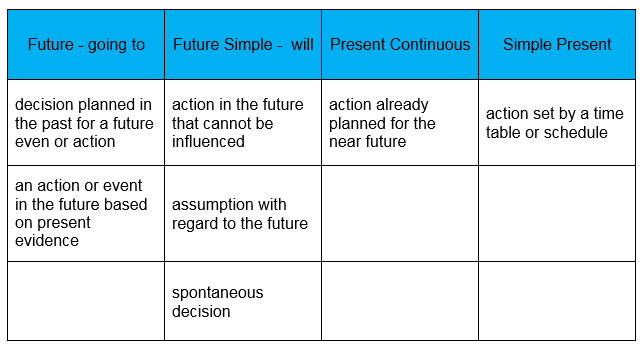Form, Use and Meaning
In Future Forms 1, we focused on will, going to and the present continuous. In this package we will review these structures and go on to look at some other ways of talking about the future.
This table presents the three future structures we have already covered plus the simple present tense which is also used to talk about the future.

Present simple
The present simple tense is used to talk about a future action or event set by a time table or schedule. Look at this example.
The plane leaves at 1.30 in the morning.
Although the action takes place in the future, it takes place regularly and is set by a time table.
Activity 1
Choose the correct future form in the sentences below.
Now type in the correct form of the verb in the space provided.
Exercise 2
Put the verbs into the correct form using either will, going to, simple present or present continuous.
Future continuous
The future continuous emphases the course of an action taking place in the future.
Form

Use
- action that is going on at a certain time in the future
- action that is sure to happen in the near future
Signal Words
- in one year, next week, tomorrow
Exercise 3
Type in the correct form of the verbs (future continuous).
Future Perfect Simple
Future Perfect Simple expresses an action that will be finished by a certain time in the future.
Form

Use
- action that will be finished by a certain time in the future
Signal Words
Exercise 4
Type in the correct form of the verb (future perfect simple).
Future Perfect Continuous
The Future Perfect Continuous emphasises the course / duration of an action taking place before a certain time in the future. It can also be used to express an assumption regarding a future action. The Future perfect continuous is not used very often as it can usually be replaced by future perfect simple.
Form

Use
- action taking place before a certain time in the future
- puts emphasis on the course of an action
Signal Words
- for ..., the last couple of hours, all day long
Exercise 5
Type in the correct form of the verbs (future perfect continuous).
Click the tabs to show contents.




